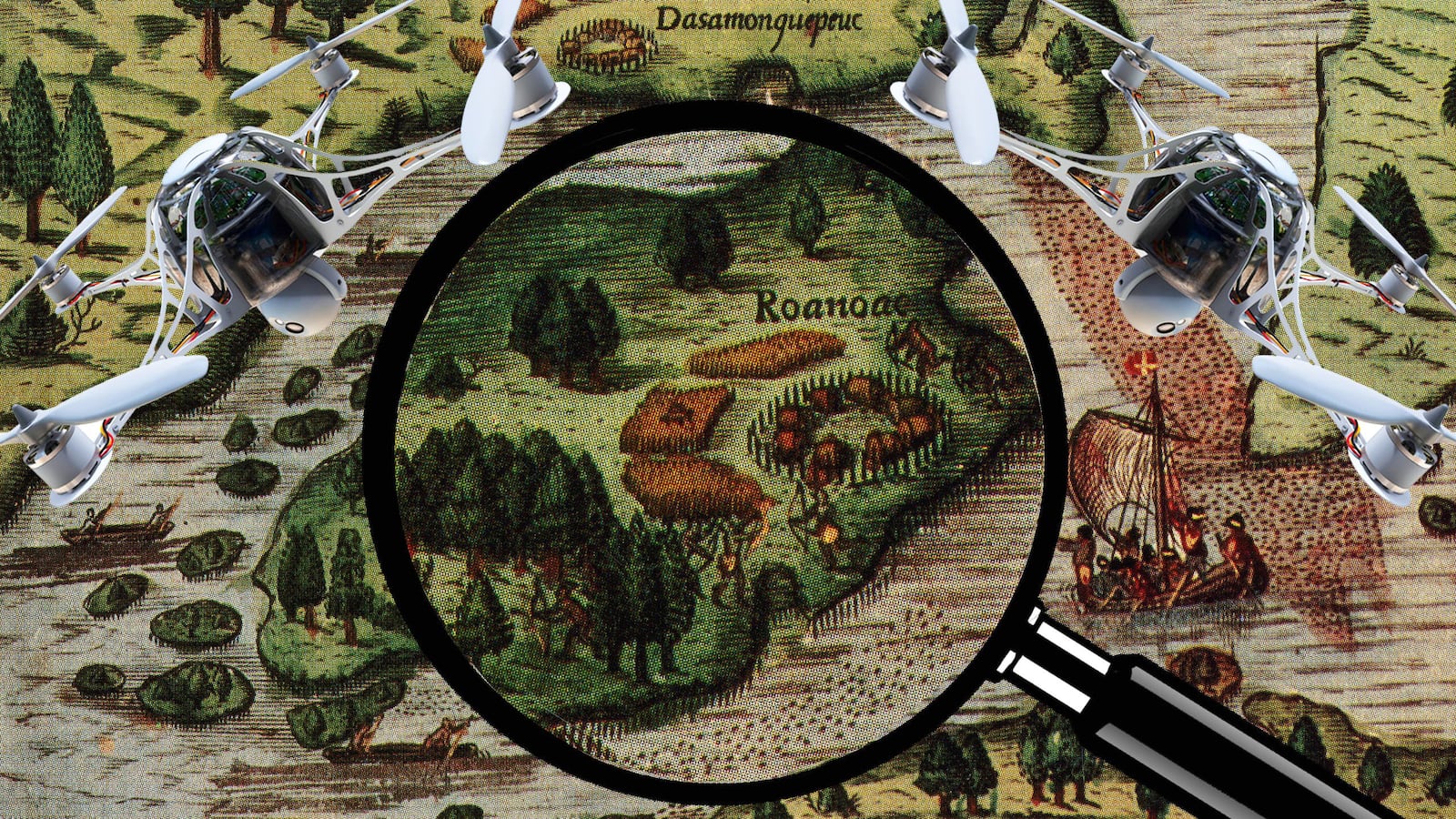As viewers tune in for the pig-wallow witchcraft of American Horror Story: Roanoke, the real Roanoke Island remains a favored haunt of scientists, not spooks. From the beginning, England’s ventures in the New World were largely scientific: scope out the precious metals and botanical treasures, and make a killing for Sir Walter Raleigh and the British Crown. It didn’t turn out that way.
You’ll remember the gist: In 1587, John White and some 117 brave souls ventured across the Atlantic to build a city on the shores of the Chesapeake Bay. Their pilot ditched them instead on Roanoke Island, an eight-mile sickle of land behind the storm-lashed Outer Banks of today’s North Carolina. White spent six weeks getting the colonists settled, then weighed anchor for England, promising to return with supplies.
Three years later, when he finally made good on that promise, the colonists had vanished, along with White’s granddaughter, Virginia Dare, the first English child born in North America. Taking his cue from the word Croatoan etched in a palisade post, White sailed for Croatoan—on today’s Hatteras Island—but a storm forced him out to sea and back to England. The colony he’d founded was lost.
And it’s still lost, but maybe not for long. The mystery of the Lost Colony, insists archeologist Eric Deetz, can be solved. “If I didn’t think so, I wouldn’t spend so much time out in the woods, digging stuff up,” he says.
Deetz, a board member with the research-minded First Colony Foundation and a lecturer in anthropology at the University of North Carolina at Chapel Hill, says the tools of modern science are turning up a trail of new clues. This summer, scouting a Roanoke Island shoreline for the National Park Service, Deetz dug up eight blue-and-white shards of a tin-glazed pottery jar or vial, of a type manufactured for only a few decades around the time of the First Colony. The container almost certainly came ashore with the colonists or another expedition two years earlier, Deetz says, and the jar’s purpose was probably scientific, not domestic.
“These jars or vials were likely used for assaying minerals or looking at botanical items—the kind of containers you see in drawings from the period that show doctors or alchemists,” Deetz says. “So we’re using modern science to look at Elizabethan science.”
Archeologist Ivor Noel Hume drew the same conclusion back in the early ’90s, when he uncovered on Roanoke Island what he called a science workshop, including fragments of a crucible and evidence of metalworking. Historical records report that Joachim Gans, a metallurgist, and other scientists set up shop at the site during the first Raleigh-sponsored expedition to the area, in 1585.
Deetz thinks the colonists who arrived on Roanoke Island two years later came with a similar mission. “By this time, the Spanish were already hauling shiploads of gold out of South and Central America,” Deetz says. “England wanted its share, too, and something had to pay for the colony.”
Precious metals weren’t the only treasures at stake. New World plants could be as good as gold. “Thomas Hariot, who was one of the brilliant minds of the Elizabethan Age, came here looking at the scientific or medical uses of plants,” Deetz says. “Sassafras, for example, was a big deal because apparently people believed it cured syphilis.”
For today’s crop of scientists, the treasure at stake is an answer: what happened to the Lost Colony? It’s a mystery that still packs enough suspense to mobilize several teams of archeologists aiming high-tech hardware at the sandy soils of coastal Carolina. Magnetometers alert them to buried metal. Ground-penetrating radar picks up shadowy changes in density where objects are buried or ground has been dug. And when an artifact does turn up, archeologists can summon the magical powers of subatomic physics to pin down its age.
This new tool of physics, Deetz says, “sounds like make believe, but it works.” It’s called optically stimulated luminescence, and it can help date a layer of soil, give or take a year or two, and therefore the artifacts buried within it. A high-tech probe burrowed into the ground sets off a reaction in the quartz and other minerals, releasing trapped electrons and revealing when the soil last saw sunlight.
But even as these powerful tools probe the ground, archeology, always so down-to-earth, has also gone airborne. That svelte little drone cruising just above the forest canopy of Bertie County, N.C., back in July? It was packing Lidar, a radar-like device that uses lasers to peer through vegetation and detect patterns etched in the earth.
And if you have an X-ray eye that even Superman would envy, where do you aim it? At Site X, of course.
Site X occupies a bank of Albemarle Sound, about 50 miles inland from Roanoke Island, near Edenton, N.C., and it’s added a tantalizing new twist to the mystery. Deetz and his colleagues began exploring the tract after 2012, when spectroscopy of John White’s watercolor map of the region revealed, under a patch in the paper, an enigmatic hidden star, or X, suggesting that White had marked the spot as a possible destination for the colonists.
Did the First Colony pull up stakes and head for Site X? Maybe so. The site has already surrendered several shards of Elizabeth-era pottery, gun parts, a tenterhook, and various other goods of the type Roanoke Island colonists would have used. And Deetz thinks there’s more to come.
Meanwhile, a second research team is working the site of another possible refuge, near Cape Creek on Hatteras Island. Mark Horton, an archaeologist at Britain’s Bristol University, found a trove of Elizabethan-era artifacts, including the hilt of an iron rapier, several other metal objects, and a small piece of slate with a pencil, suggesting that colonists made it to the site and brought their homework.
Both sites are yielding the right stuff from the right era to qualify as Elizabethan. But the Lost Colony, Deetz says, is, for the moment, still lost. “The work on Hatteras Island has the same problem we have at Site X. Both teams have found artifacts that are portable. These things could have been picked up by the Algonquians when they were sort of rummaging around Fort Raleigh after it was abandoned. We won’t really know that happened until we find an English skeleton buried in an Algonquian village, or the remains of an English-style house.”
Or, if another group of sleuths have their way, we’ll find the colonists by detecting their DNA in the living, breathing bodies of their descendants.
Anne Poole and Roberta Estes, who share a lifelong passion for Lost Colony history, have been using a commercial DNA site (FamilyTreeDNA) to gather and analyze cheek swabs from people whose ancestors had surnames listed among those of the first colonists. They’ve also collected oral histories, noting when family lore claimed a link to the colony. Poole is convinced that the Roanoke Island colonists journeyed to Croatoan, now Hatteras Island, and took up with the tribe.
“No, we can’t prove it—yet,” says Poole, who directs the Lost Colony Research Group she and Estes established. “But we’ve found a few promising leads.”
Some of those leads are turning up among the Lumbee Tribe, which traces some of its ancestral roots back to the Croatoan. “We have several Lumbee people who share DNA and have the same surname as one of the colonists,” Poole says.
One of the most striking connections so far involves females with shared DNA and the name Berry in their family trees, Poole says. She needs samples from descendants of family members who remained in England, but so far the Brits have said no to the swabs. “It’s a cultural thing,” Poole says. “They just don’t like the idea of turning over their DNA. But that could change, so we’ll keep trying.”
Like Poole, Eric Deetz imagines a mostly peaceful fate for the survivors of the First Colony—procreation not annihilation. He doubts that some warring tribe massacred the colonists and looted their settlement. “I’m in the assimilation camp,” he says. “When I look at the historical record, I don’t see evidence for concluding that native people exterminated the colonists.”
Deetz finds it more likely that colonists moved to Croatoan, Site X, or both and adopted the ways of their hosts. After all, the lifestyles of the English weren’t so different from those of the natives, he says. “What they ate and how they lived were similar enough that it wouldn’t have been a jarring adaptation. And a lot of reports from that period show that the English looked on the Native Americans and their lifestyle with admiration, and didn’t think of them as dirty savages.”
If Deetz is right, he or one of his colleagues may eventually find the conclusive evidence they’re hunting, in the remains of an English building or in the bones of an English burial ground. Deetz says he’ll head back to the field in late October, to dig his way through some landscape where Lidar and ground-penetrating radar spotted promising “anomalies.”
“With this scientific approach, and the tools we have today, we can narrow the search,” Deetz says. “We don’t have to dig through hundreds and hundreds of acres, hoping we’ll turn something up.”
And who knows? If modern science can find King Richard III under a parking lot, maybe it can find Virginia Dare cradled among the wizened old roots of a spreading live oak.
Neil Caudle is a science writer and novelist who lives near Chapel Hill, N.C.






